All About Eye Bolts

The word "eye" in translation from Dutch means "ring" - from which the name of the fastening element eye-bolt came. Its main purpose is to raise, lower or hold structures by weight during installation work or cargo transportation.
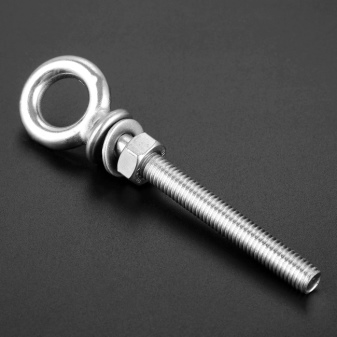
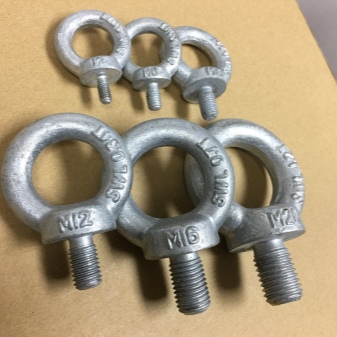
What it is?
A universal lifting device with a collapsible connection, designed for lifting or transporting any goods, and there is an eye bolt. It looks like a long screw rod with a ring at one end. For production, steel GOST 1050-84 is usually used, the grade of which must be at least 20 or 45. Physical and mechanical characteristics must pass quality control and be confirmed by special documents. Certification occurs by random selection of finished products: a check is carried out for the presence of voids, identification of poor-quality threads or welded sections.
The produced eye bolts differ from each other in such parameters as the length of the applied thread and the tolerance to its diameter. But according to the technical conditions GOST, DIN and ISO, the requirements remain the same:
- size ruler;
- thread diameter size;
- product weight;
- steel grades used for production;
- strength and carrying capacity;
- operating conditions.

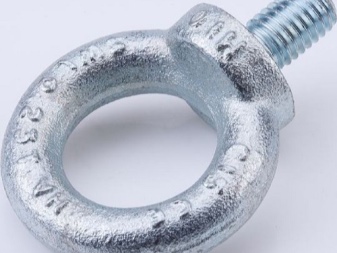
Features of production
For the manufacture of eye bolts, two technologies are used - casting (forging) and stamping. Steel is used either carbon or alloyed. These are high-strength types of metal, the differences in which are in the direction of application, that is, some eye bolts can be used for any purpose, others - for conditions of high humidity. Low-carbon steel products undergo a mandatory galvanizing process, thanks to which they do not corrode. Alloy steel hardware is no less durable, but their surface can rust over time. In total, there are several methods of galvanizing.
- Galvanic. Fasteners are placed in the container where the dissolved zinc salts are located. Then electricity is passed through - thanks to this action, the zinc particles remain on the bolts.
- Hot. Products are placed in zinc heated to a temperature of 465 ° C. This method is used most often as it is more economical and reliable. Hot-dip galvanizing increases the anti-corrosion resistance of the bolts.
- Diffuse. Parts are processed with zinc powder at a temperature of 290-450 ° C or with zinc vapor at 800-900 ° C. This method can be compared to a hot one, the only drawback is that the appearance of the finished product "suffers".
- Cold. A special solution containing zinc powder is applied to the finished parts. Here, the resistance to rusting is higher than with electroplating, but lower than with hot-dip galvanized.
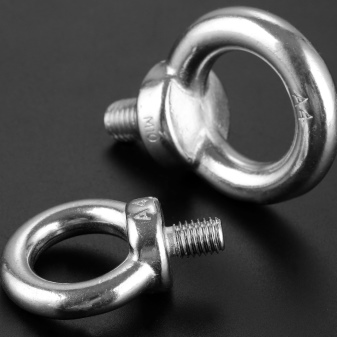
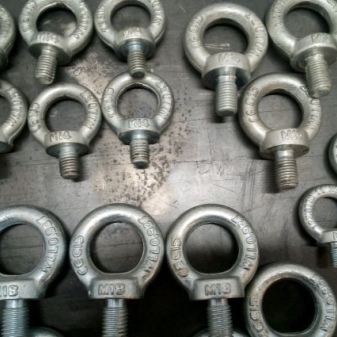
Manufacturing by casting is complex, but fasteners are more accurate and stronger. The eye bolts made in this way can differ in size (several millimeters), but this difference is allowed by GOST standards. The stamping method is simple - here the work takes place on specialized machines. The heated metal is poured into molds.
For some fasteners, there is an additional item - this is the heat treatment process. Burrs may appear on the bolt ring during production using this method. This is acceptable because they can be easily removed without causing damage to the fasteners themselves.
At the same time, the requirements for the rod are higher - burrs and dents are unacceptable here.
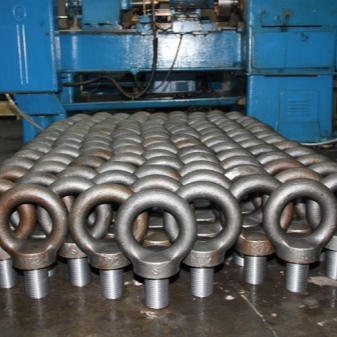
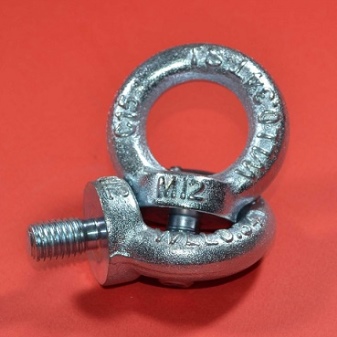
Applications
Due to their specific purpose, eyebolts are used in many areas:
- construction - used in installation work, for moving and loading and unloading any structures, for work at height;
- production of vehicles - here, with their help, towing is carried out;
- rigging - all kinds of movements of heavy loads (lift, load, unload, rearrange and more).
And also fasteners are often used in the conduct of work, which must be completed in a short time - for example, the installation of tents, circus domes, tents. Street advertising and similar systems are also mounted using eyebolts. It is generally accepted that eye bolts were first used in shipping. On floating structures (on a boat, yacht, ships) fasteners were installed for mooring to the shore.
The bolt can be installed both on the equipment itself and on its assemblies.
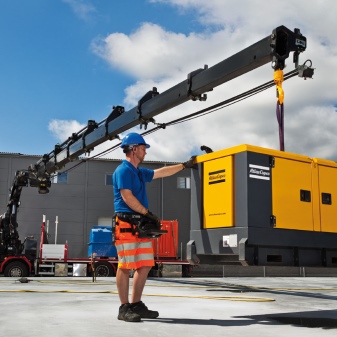
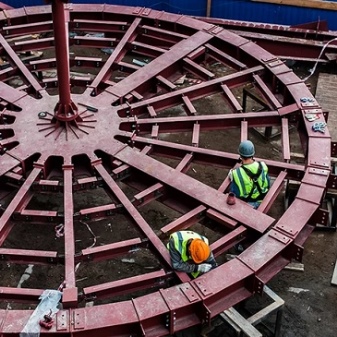
What are they?
An eye bolt or a bolt with a ring - this is what fasteners are called in plain language. There are 2 options for the design of the eyebolt:
- the ring is attached to the rod strictly perpendicularly;
- the ring is installed in a special groove, it can rotate in different directions.
And also for the convenience of gripping the load at the bolt, instead of the ring, a hook can be installed.
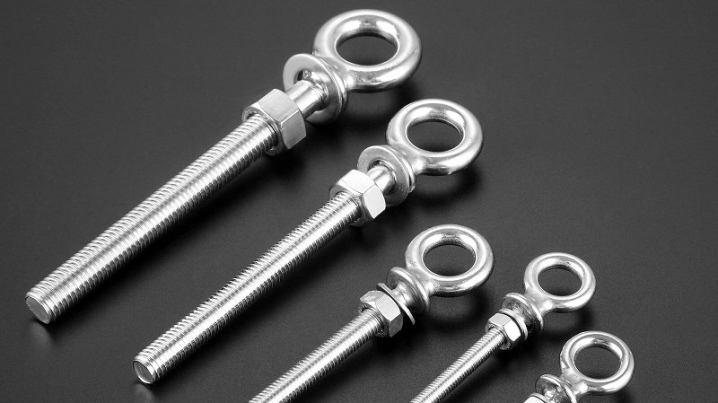
In addition to hardware made according to standards, other types are distinguished.
- Elongated. Has a long threaded rod.
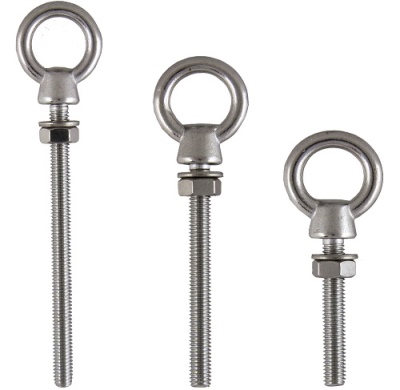
- Anchor. Used when working with concrete structures or natural stone. The product is distinguished by the presence of a nut, washer and spacer. It is convenient to install fasteners with an anchor on problem substrates. There are 4 types of anchor bolts.
- Wedge - looks like a sleeve, inside which there are rings.
- Hammered - a special type of bolt, its edges are made of soft metal, which deform when hammered. Thus, anchoring in the surface is carried out.
- Expandable fasteners are the most popular and versatile fasteners. It is made in the form of a rod with slots, thanks to which the walls seem to "open up" when screwed in.
- Spacer - This bolt is also very popular. Most often used in the construction industry. It looks like a cone, the rod of which expands after screwing in. Applicable only for concrete and brick.

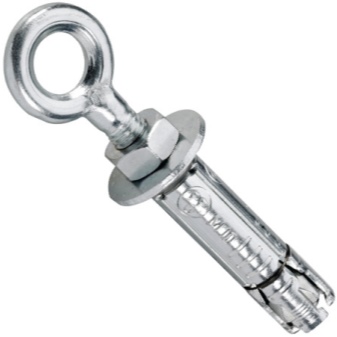
- Pivot bolt used to move goods in any direction. There are products of double rotation - 360 °, as well as rotary ones - 180 °.
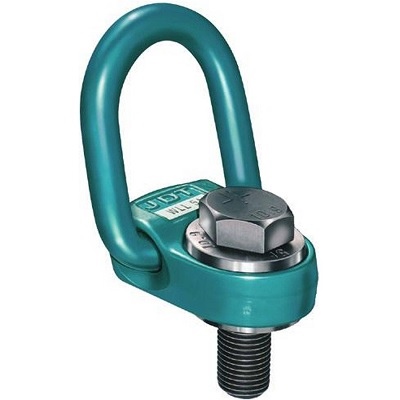
- External thread bolts. They are installed in specially prepared holes and are fixedly mounted.

- Bolts with an unthreaded shank. They are used very rarely to create a swivel joint.
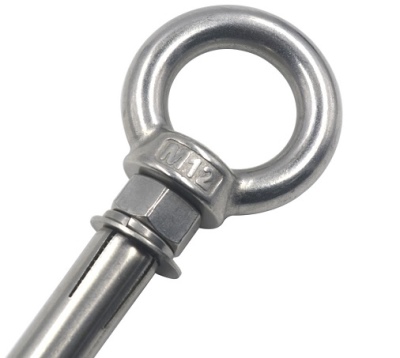
According to the type of material, fasteners are galvanized and alloyed or stainless. What the lifting capacity will be depends on the degree of fastening - axial, at an angle of 45 °, if the bolt is installed on the side. According to GOST and DIN standards, the width of the shoulder, that is, the protrusion of the screw part, varies from 17 to 120 millimeters. Each eyebolt has its own specifications. Fasteners differ in the size of the thread diameter and the diameter of the shoulder, in the pitch of the screw thread, in the load from the diameter, in the inner and outer dimensions of the ring and its thickness, in the length of the threaded part, in the permissible tensile load at an angle of 45 ° and relative to its axis.
Designated as M4, M5, M6, M8, M10, M12, M14, M16, M20, M24, M30, M36, M42, M48, M56, M64, M72, M80 and M100. For all these characteristics, the carrying capacity can vary from 80 kilograms to 40 tons.
A special cargo bolt can also be distinguished, consisting of a ring mounted by a threaded rod on the parts of various machines and apparatus. Such fasteners are an integral part of them.
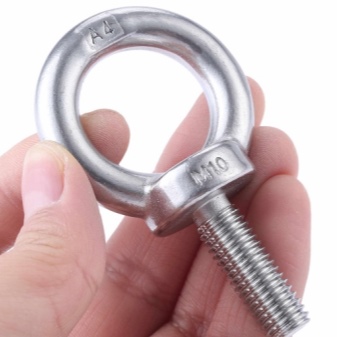
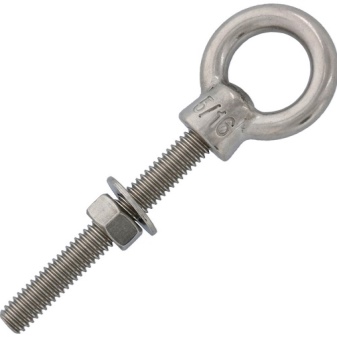
Operating tips
It is necessary to start the installation of the eyebolt with the preparation of the hole. The process is carried out using a drill, then the installation of fasteners is already taking place. Accordingly, for a secure installation, the drill must be identical to the diameter of the bolt.
Installation specifications:
- fasteners must be tightly tightened;
- the screw rod must be screwed at least 90% into the surface - this parameter can be adjusted using a special washer or gasket;
- only one rope, chain, rope and more can be connected to one bolt;
- before installation, all interacting elements (bolt and hole) must be cleaned of dust and dirt;
- when installing fasteners, you need to make sure that the screw part fits correctly into the prepared hole;
- the axis of the hardware must be at right angles to the axis of the hole.
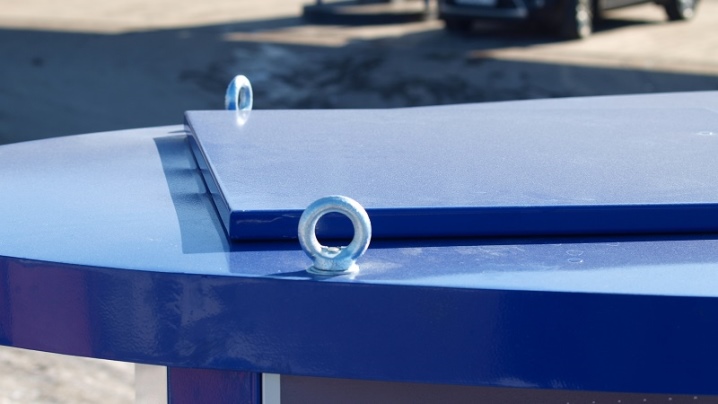
Consider separately the installation conditions for the anchor eyebolt.
- The length of the fastener is selected according to the thickness of the surface. The anchor is screwed into the concrete by at least 5 centimeters.
- The place where the fasteners will be installed must be selected correctly the first time. Dismantling and reinstallation is very difficult.
- The mounting hole must be compatible with the bolt diameter. To screw in the hardware, an effort must be made.
- As with conventional eyebolts, the anchor hole is cleaned of dirt before installation.
- The spacer type is driven in with a hammer.

In the next video, you can take a look at the production of eye bolts in accordance with GOST 4751 73.













The comment was sent successfully.